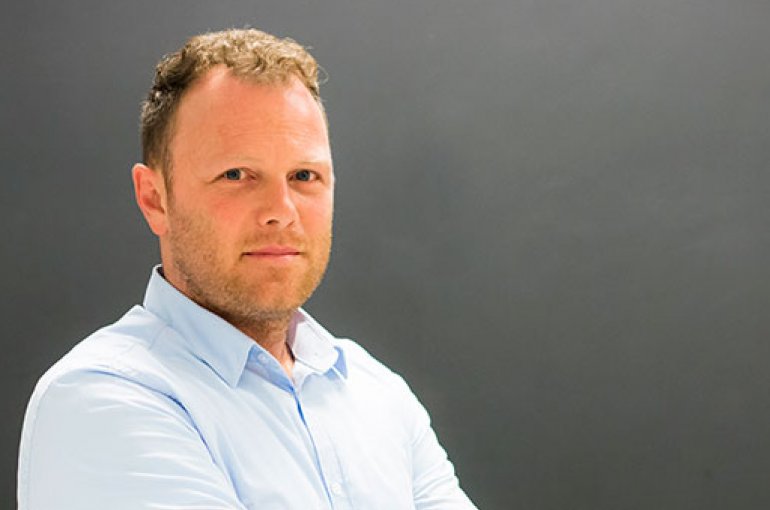“Developing new antibiotics is an arms race”
ERC Consolidator Grant for pharmaceutics researcher Nathaniel Martin

Antibiotics are essential, not only to combat short-term infections, but also to prevent infections during surgery and chemotherapy. However, bacteria are becoming increasingly resistant to antibiotics, which is reason for great concern. Nathaniel Martin (Pharmaceutical Sciences) has received an ERC Consolidator Grant of 2 Million Euros to combat antibiotic resistance. “Developing new antibiotics is a bit of an arms race,” Martin explains, “and the role of academic research is essential.”
In September of this year, the UN issued a global health warning concerning antibiotic resistance, a declaration previously reserved for extremely dangerous diseases like ebola and HIV. “For many people and companies, antibiotic resistance doesn’t feel very urgent, because it’s been growing rather slowly in the background,” Martin says. However, an estimated 700,000 people are now dying annually because of antibiotic resistance, and that number will only grow, with estimates of multiple-millions of deaths per year by 2050. The first to feel these effects are the young, elderly and chronically ill, especially in developing countries.
New antibiotics strategies
Despite a clear need, since the 1980’s, many companies have stopped developing antibiotics, and in the past 50 years, only three new classes of antibiotics have been developed. “Developing new antibiotics isn’t a very good investment for pharmaceutical companies,” Martin explains. “Antibiotic treatments are typically short, so the revenues are relatively small. Also, bacteria will eventually become resistant, which means that antibiotics have a finite lifespan. So I feel that it’s up to academia to identify promising new antibiotic molecules and strategies, which can eventually be taken up by pharmaceutical companies for further development.”
Martin’s research project will encompass three parallel lines concerning drug resistance. The research lines will all target the ESKAPE pathogens, a group of six bacterial pathogens which are relatively common and the most worrying with respect to antibiotic resistance. Very worrying are recent reports of some ESKAPE pathogens that exhibit resistance to virtually all clinically-used antibiotics. Martin explains: “Right now, if you’re infected with one of these pan-resistant pathogens, the only thing you may be able to do is wait it out and hope your immune system is strong enough to let you survive.”
Making natural antibiotics stable
Penicillin, the very first antibiotic discovered, came from a natural source, and it is still nature that inspires Martin’s research. “When you think about it, penicillin is really weird. It’s produced by a fungus that didn't evolve to help us, but the penicillin molecule works very well in our bodies. In the twenty years following penicillin’s discovery, a number of natural substances that could be directly used as antibiotics were identified, the so called ‘low hanging fruit’. By comparison, discovering new antibiotics today is much more challenging. There are however many other natural substances that work against bacteria, but they are not stable for use in the human body, so we need to make chemical modifications to make them suitable as medicines.”
An example is the antibiotic nisin, which was discovered in the same year as penicillin. Nisin is very potent in killing bacteria, but before it gets the chance to do so in the human body, it is degraded by enzymes in the bloodstream or stomach. Nisin has found use for decades as a preservative, to prevent bacteria from growing on food, and to date, no reports of nisin-resistant bacteria have been found. “That’s a good sign, of course,” says Martin. “Now we need to find a way to make it suitable for use as medicine.”
Killing drug-resistant pathogens
Martin will also study the lipopeptide antibiotics, a family of naturally occurring molecules produced by bacteria, for which his research group has developed an efficient chemical synthesis. “Our experiments have already shown that these lipopeptides work as antibiotics and synthesizing these molecules allows us to learn more about how they work, and how to possibly improve them.” The lipopeptide antibiotics target a key bacterial lipid, against which there are no antibiotics yet. “Such compounds might also work well in synergy with existing antibiotics,” Martin says. “Perhaps we can use these molecules to make a bacterium vulnerable, and then use another type of antibiotic to kill it.”
Repairing broken antibiotics
The third research line is the most uncertain, but in the end, may be the most impactful. “Drug resistance has rendered some whole classes of antibiotics useless. But we may have found a way to restore their effectiveness by ‘resensitizing’ resistant bacteria to them.” A high-profile publication is still in preparation, so Martin cannot say much more about it. “It is very promising. We’ve already shown that our approach works in live bacteria, but we still need to conduct key experiments to validate the proposed mechanism.”
Essential collaborations
Martin started working on antibiotics during his PhD at the University of Alberta. “Back then, I was already very interested in what researchers at Utrecht University were doing.” After a Postdoc in Berkeley, a Veni grant allowed him to come to Utrecht. Martin received a Vidi grant directly afterwards, which was the foundation for this ERC Consolidator project.
In the ERC project, Martin collaborates with the Medical Microbiology group at UMC Utrecht, the CBS Fungal Biodiversity Centre, and colleagues from the Utrecht University chemistry department. “The collaborations are essential, and they make this research project really exciting,” says Martin. “In some cases we’re working with bacteria that have been isolated from a real patient as little as two weeks ago. It’s one of the great things about working in the Pharmaceutical Sciences in Utrecht: it provides an environment spanning the complete spectrum from fundamental drug design all he way up to very applied research.”

